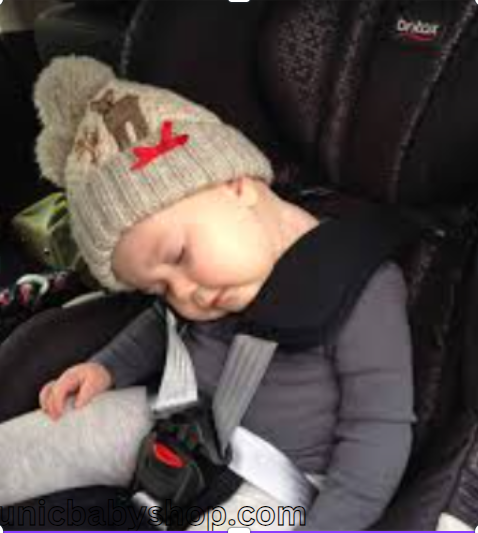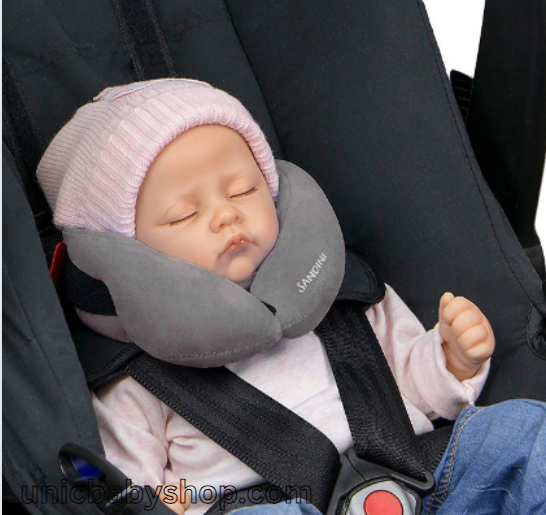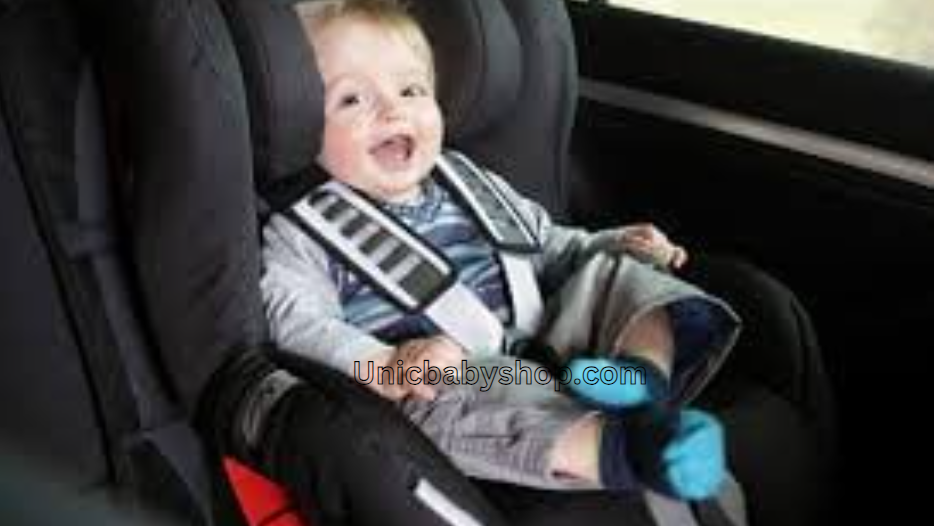Ensuring your baby’s head falls forward in car seat safety while traveling in a car seat is essential for their well-being and peace of mind. The position of a baby’s head in a car seat is a common concern among new parents, especially during long trips or when the child falls asleep.
An incorrect car seat angle or loose harnesses can cause the baby’s head to fall forward, potentially leading to breathing difficulties and uncomfortable sleeping positions. Ensuring the correct angle for the car seat and comfortably adjusting the harness are imperative steps to mitigate this problem. Parents should read the car seat manuals carefully and seek professional guidance, if necessary, to ensure that the car seats are installed and we
ed properly by the manufacturer’s instructions and safety regulations.
The Risk Of A Tilted Head In Car Seats
Parents often worry about their baby’s comfort and safety in a car seat. A common concern is when the baby’s head falls forward. This situation may seem uncomfortable, but it can also present risks. Understanding these risks helps parents take steps to ensure their children remain safe and comfortable during car trips.
Potential Dangers Of A Forward-falling Head
When a baby’s head tilts forward in a car seat, it can lead to several potential dangers:
- Blocked Airways: The head slumping over can restrict the airway, making breathing difficult.
- Neck Strain: Prolonged head tilt can strain the baby’s neck muscles and spine.
- Uncomfortable Sleep: Babies may sleep poorly or wake frequently due to discomfort.
- Decreased Safety: In an accident, an incorrect head position can reduce the car seat’s ability to protect the baby.
Reasons For Head Slumping In Infants
Diverse factors cause an infant’s head to slump forward in a car seat, including:
- Improper Installation: Car seats not installed at the right angle can tip a baby’s head forward.
- Loose Harness: A harness that isn’t snug may allow a child to slump down or forward in their seat.
- Underdeveloped Neck Muscles: Infants lack the strength to hold their heads for long periods.
- Car Seat Design: Some car seats might not support a baby’s head and neck adequately.
Ensuring the car seat is appropriate for your baby’s size and installed correctly ensures a safer ride. Parents can consult car seat manuals or a certified car seat technician for guidance.
Correct Car Seat Installation
baby’s head falls forward in car seat safety in the car is crucial. Proper car seat installation ensures your little one’s safe ride. Neglecting this vital step can cause your baby’s head to fall, causing discomfort or injury. Let’s dive into installing a car seat for optimal safety.
Ensuring Proper Angle And Position
Setting the correct angle for a car seat is imperative. Reclining too upright can cause the baby’s head to fall forward. On the other hand, reclining too much can also be dangerous in the event of an accident. Most seats have built-in indicators or angle adjusters to help you find the sweet spot.
- Check the level indicators on the car seat side or base.
- Adjust the seat so that it matches your vehicle’s back seat angle.
- If allowed, use a rolled towel or pool noodle under the base to achieve the necessary angle.
Importance Of Following Manufacturer Instructions
Car seats come with manuals for a reason. Each model has specific requirements and guidelines essential for your child’s safety.
- Read the manual thoroughly before installing the car seat.
- Look for weight and height limits to ensure your child fits the seat’s specifications.
- Apply the car seat’s recommended installation method: Whether using LATCH or a seat belt, follow the steps carefully.
Remember that proper installation is only completed by partnering with the car seat manufacturer. This step ensures that you receive critical security updates and withdrawal notifications.
Choosing The Right Car Seat
Securing the baby safely in the car is essential for traveling parents. One concern is the baby’s head falling forward in the car seat. The right car seat can make all the difference. This section helps you make the best decision for your baby’s safety and comfort.
Evaluating Car Seat Designs For Infants
Consider the following features:
- Rear-facing design: Your baby should ride in a rear-facing seat. It’s safest.
- Five-point harness: This keeps your baby snug and secure.
- Adjustable base: This feature allows you to angle the seat correctly.
- Side-impact protection: It offers extra safety for your baby.
Select a seat that grows with your child. Convertible seats save money over time.
An appropriately sized car seat is essential. The car seat must fit your baby’s size and weight.
Importance Of Head Support Features
Head support is vital. It prevents your baby’s head from slumping forward.
Look for car seats with:
- Adjustable headrest: It ensures a snug fit as your baby grows.
- Integrated head support: Some seats come with built-in support for infants.
- Additional inserts: They may be necessary for newborns for extra support.
Ensure the seat provides proper recline. It encourages a natural, safe sleeping position.
Always read the manufacturer’s instructions. This ensures the correct usage of head support features.
Head Support Accessories
When you travel with a baby, ensuring their comfort and safety is essential. Sometimes, a baby’s head can fall forward in her car seat, which can be uncomfortable and unsafe. To solve this problem, head support accessories can be a worthwhile investment. These products keep your baby’s head more stable and secure during car rides.
Selecting Safe Head Support Products
Choosing the right accessory ensures the safety and comfort of your little one. Remember these selection tips:
- Check Compatibility: The product should fit your car seat model perfectly.
- Look for Quality Materials: Soft, breathable fabrics are best for a baby’s delicate skin.
- Non-restrictive Designs: Ensure it does not interfere with car seat straps.
- Safety Certifications: Always opt for products with recognized safety certifications.
How To Use Neck Pillows Correctly
User instructions for neck pillows:
- Fit to Baby: The neck pillow should snugly surround the baby’s neck without pushing their head forward.
- Secure Positioning: Place it below the ears and around the neck to stabilize the head.
- Monitor Baby: Monitor the baby to ensure the pillow remains in place.
- Avoid Overstuffing: Avoid overly thick or stiff pillows that might affect posture.
Monitoring Your Baby’s Position
Mantener la posición correcta de su bebé en un asiento de seguridad es fundamental. Los mantiene seguros y cómodos. La caída de la cabeza de un bebé hacia adelante puede ser alarmante: puede dificultar su respiración y causar malestar. Los controles constantes garantizan que permanezcan en una postura segura durante todo el viaje.
Signs To Look For While On The Road
It’s essential to stay vigilant for tell-tale signs that your baby’s position needs attention. Look for these key indicators:
- Chin Slumping to Chest: This position can restrict airways.
- Restlessness: Indication your baby isn’t comfortable.
- Red Marks: Straps might be too tight, causing skin irritation.
- Slouching Sideways: Lack of proper head support is likely.
Adjusting Your Baby Mid-trip
If your baby’s head drops forward, careful adjustments are necessary. Try these mid-trip corrections:
Stop in a safe place before making adjustments.
Recline the car seat to get a better angle.
Check the harness: it should fit snugly over your shoulders.
Use a rolled wipe for added support, as the car seat manufacturer allows.
Always refer to the car seat manual for specific instructions. Proper installation and positioning are non-negotiable for your baby’s safety.

Educational Resources For Parents
Ensuring your baby’s safety in a car seat is crucial. A baby’s head falling forward can pose serious risks. Parents need reliable information to avoid this. With proper guidance, car seat safety becomes more manageable. Explore educational resources designed for parents who want to provide the best protection for their little ones while traveling.
Car Seat Safety Workshops And Webinars
Local hospitals and child safety organizations frequently host workshops and webinars. These sessions offer hands-on training and updated safety protocols. Find a session near you:
- Check community boards at pediatric clinics and community centers.
- Visit the National Safety Council websites for schedules.
- Search for ‘car seat safety events’ on social media platforms.
Experts teach you how to avoid common installation mistakes and show you how to properly secure your baby’s head. Participate in Q&A sessions to get personalized advice.
Trusted Online Guides And Videos
Many organizations offer free online resources. These include step-by-step guides and instructional videos. Here’s how to access this vital information:
- Search for car seat safety videos from reputed child safety brands.
- Bookmark guides from official transportation authorities.
- Subscribe to channels specializing in child car seat reviews and tips.
These resources show you the proper fit of car seats and demonstrate the correct way to position a baby’s head. Observe and re-observe as necessary to reinforce your understanding.
When To Seek Professional Assistance
Watching your baby’s head fall forward in their car seat can be worrying. Parents often ask: when is the right time to receive professional help? If you adjust your baby’s car seat and posture correctly, but her head still falls forward, seek help from the experts.
Consulting A Child Passenger Safety Technician
A child passenger safety technician (CPST) is trained to help with car seat problems. Contact a CPST if:
You have tried to fix the recline angle but have yet to succeed.
The harness straps are not secure enough.
You wonder if the car seat is right for your child.
They will assess the situation and provide a personalized solution, ensuring your baby travels safely.
Car Seat Inspection Stations
Car seat inspection stations offer professional evaluations. They check if:
The car seat is installed correctly in your vehicle.
Your baby is adequately secured in the seat.
The car seat has no recalls or defects.
The experts at these stations help correct any problems on the spot. Use safe car seat practices to protect your valuables.
Staying Updated With Car Seat Safety
When your precious little one’s head falls forward in a car seat, it can cause concern. Safety becomes paramount when transporting your bundle of joy. Staying informed about the latest updates in car seat safety is essential. Awareness of recalls and changes in laws can protect your child. Let’s explore how to keep your baby safe while traveling.
Keeping Abreast Of Car Seat Recalls
Car seat recalls alert parents about potential safety issues. Manufacturers could recall seats due to defects. These defects could compromise the safety of your child. Here’s how you can stay informed:
- Register your car seat with the manufacturer. You will be notified of recalls.
- Visit the National Highway Traffic Safety Administration (NHTSA) website periodically. For security reasons, they list all withdrawals.
- Sign up to receive email alerts from child safety organizations. They provide updates on product security.
Reviewing Changes In Child Safety Laws
Child safety laws can change. Stay ahead by understanding the requirements of your area. Each state may have different laws. Make sure your little one stays safe with these steps:
Action
Description
Check State Laws
Visit your state’s transportation website. Find the latest child safety seat laws.
Talk to child safety seat inspectors. They can tell you about laws and best practices.
Local hospitals and police departments often offer car seat safety checks.
Consult Experts
Visit your state’s transportation website. Find the latest child safety seat laws.
Talk to child safety seat inspectors. They can tell you about laws and best practices.
Local hospitals and police departments often offer car seat safety checks.
Community Resources
Visit your state’s transportation website. Find the latest child safety seat laws.
Talk to child safety seat inspectors. They can tell you about laws and best practices.
Local hospitals and police departments often offer car seat safety checks.
By regularly reviewing the laws and following recall alerts, you can ensure that your baby’s trip remains as safe as possible.
Frequently Asked Questions Of Baby’s Head Falls Forward In Car Seat
Why Does My Baby’s Head Slump In The Car Seat?
Proper car seat recline and support often prevent the baby’s head from falling. Consult the car seat manual. Adjust the seat according to the recommended angles. Make sure the headrest provides adequate support.
How To Prevent Baby Head Flop In Car Seat?
Use approved head supports and check car seat installation. Harness straps should be tight but not restrictive. They can prevent the head from falling forward. Only add aftermarket products if they have been crash-tested with the seat.
Is Baby Head Falling Forward In Seat Dangerous?
Yes, it is potentially dangerous as it can restrict breathing. Always make sure the car seat is at the correct angle. Also, adjust the head support. Babies lack neck strength, so proper support is essential for their safety.
What Car Seat Angle Is Safe For Newborns?
Newborns require a car seat angle between 30 and 45 degrees. This reduces the risk of your head falling forward. Always use a properly installed, peer-reviewed car seat for newborn safety.
Conclusion
Ensuring your baby’s safety on the road is essential. A safe, properly adjusted car seat can prevent your baby’s head from hanging forward. Regular checks and correct use offer peace of mind. Stay informed, stay safe, and enjoy the journey with your little one.
Remember, your well-being is always the priority.



